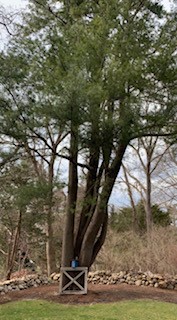-

We all know how useful trees are in beautifying the environment we live in. We are sure you can attest that trees are everywhere but do you know their anatomy? The same way you as a human being have anatomy, trees also have their unique anatomy that you should be aware of.
Having a good knowledge of the anatomy of trees will make you know how best to take care of them. A tree usually has a trunk that provides support to the leaves and branches that are found above the ground.
A normal tree has three components and they are:
- The trunk or stem
- The roots
- The crown
The trunk or stem of a typical tree is the major organ of that tree that gives it its robust woody structure. Aside from providing support to its crown, it also acts as a pathway that supplies the crown and roots of a tree with nutrients and water. A tree can either have one trunk or many trunks.
The upper part or above the ground part of a tree has these features. Check them out:
- The crown of a tree is found at the surface.
- The foliage of a tree is another term for the leaves of a tree. Green is the common color of the foliage of a tree. The foliage also includes the scale-like material that can be seen on the junipers and also needles that are seen on the pines.
- The branches of a tree. There are small and big branches. The small branches are known as the twigs while the big branches are known as boughs. The branches of a tree help to support the growth of the foliage. The branches of a tree grow from the trunk in an upward direction.
- The trunk of a tree is that organ of a tree where the branches grow from.
- The bole of a tree is the part in between the base of the trunk and the first branch.
- The trunk and branches of a tree
All trees have trunks and branches that are found in the outer part. Trunks and branches are the significant differences between trees and plants. The trunk of a tree helps to lift the leaves above the ground thus enabling them to gain access to light to survive. The trunks and branches of a tree also help to move nutrients and water from the roots of the tree to the upper part of the tree. It also spreads the food that is produced by the leaves to various parts of the roots.
When the trunk of a tree is cut, it gives you an inner view of the various layers that it has. Let’s take a look at the cross-section of a tree.
- Medullary rays: These are living cells that are found across growth rings–they permit the easy movement of sap radially.
- Growth rings: Every year comes with a free ring of sapwood which can be easily seen.
- Bark: This is the external layer of a tree that helps to protect a tree and there are various species of barks. Also, the branches and trunk of a trunk have barks too. The bark of a tree comes from dead phloem cells that are outwardly shed. The bark of a tree insulates a tree from too much heat, it also protects it against pests.
- Phloem or inner bark: This is the next layer that is found after the cambium tissue and before the bark. Its major function is to move sap around the tree and to the roots.
- Cambium: This is the external growth layer that produces phloem and both sapwood. The cambium provides a tree with thickness.
- Sapwood or xylem. Is the third layer of vascular tissue. It helps to move sap from the roots of the tree to the crown.
- Heartwood: The major role of heartwood is to give tree support and strength. It also serves as a reservoir of oils, dyes, and sugars.
- Pith: It is found at the middle of the trunk and it provides the sapling with nourishment and also the entire tree.
- Roots
The organ of a tree that is responsible for supplying it with water and nutrients is the root. So, you must nurture it properly. The roots of a tree aid the absorption of water and nutrients, enhance the growth of a tree, provides structural support to a tree, and disseminates minerals and water to the inner trunk of a tree. The roots of a tree are found under the ground so it can absorb nutrients from the soil.
- Crown
The crown of a tree is made up of the branches that are at the upper part of the tree and the leaves. The crown of a tree helps to sieve the dust and other foreign particles that are in the air. It provides a cooling effect to the air thus offering shade and also minimizing the quantity of raindrops on the ground.
The leaves of a tree are known for manufacturing food for a tree. They have chlorophyll in them that ensures photosynthesis takes place and they are also responsible for giving the leaves of a tree its green color. Photosynthesis is the process by which the leaves of a tree make use of the energy gotten from the sun and convert carbon dioxide found in the atmosphere and water that is gotten from the soil into oxygen and sugar. The sugar that is produced is the food of the tree, it can either be stored in the roots, trunk, branches or it could be used immediately. While the oxygen that is produced goes into the atmosphere for humans to inhale.
So, leaves are the organ of a tree that aids photosynthesis to take place. The leaves of a tree come in various sizes and shapes. They can be evergreen or deciduous, tough or fragile, hairy or smooth, full or lobed, compound or simple, needle-like or broad.
Conclusion
Now that you are aware of the anatomy of trees, you should do well to learn how to maintain or take care of them properly. Tree health is very important that is why tree care should not be taken for granted. When trees are well taken care of, their life span is prolonged and they will continue to beautify the environment they are in. Look out for pest and disease infestation on your trees, practice tree trimming or tree pruning, or even tree removal if a tree service company recommends that you do, and also learn to water your tree.
Are Trees Damaging Your Property?
Sometimes one bad tree can damage your entire landscape and even your home. Consult with our trained staff for a free assessment
Available 24/7 for Emergency Service
Did lightning strike? That’s our specialty. One call and we will dispatch our emergency response team to handle all your emergency tree service needs
Hours
Monday: 7:30am - 6:30pm
Tuesday: 7:30am - 6:30pm
Wednesday: 7:30am - 6:30pm
Thursday: 7:30am - 6:30pm
Friday: 7:30am - 6:30pm
Saturday: 7:30am - 6:30pm
Sunday: Closed
We Are Serving Plymouth, MA | Milton, MA | Canton, MA
Copyright © 2022 - Lighting Strikes Tree LLC. All Rights Reserved.

